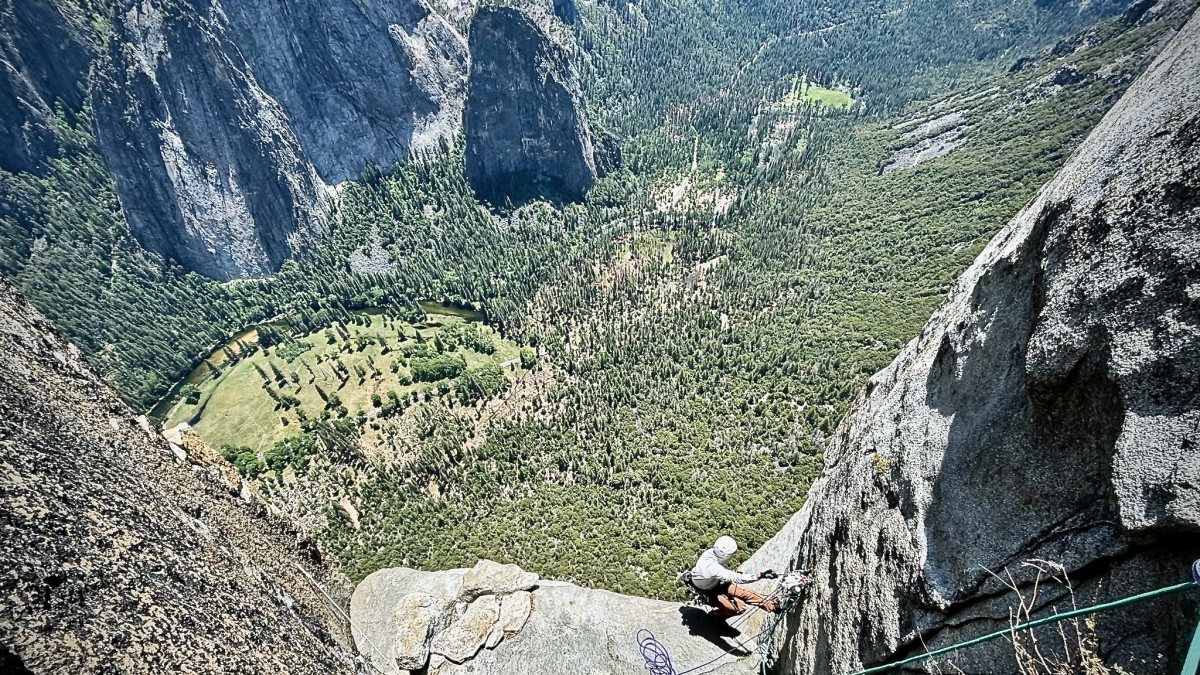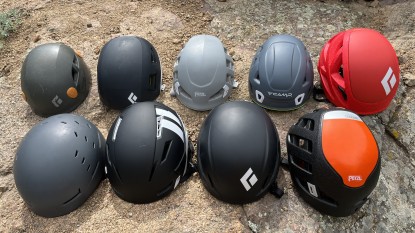Are you planning your first multi-day big wall adventure? Are you curious how the heck you're gonna be able to bring all your essential creature comforts for a good time on the ivy ledge? Not to worry, the article below has everything you need to consider when it comes to buying a haul bag. We evaluated everything from size, to materials, to closure systems, and internal pockets to determine the niche application for each haul bag that we tested. Whether you're crushing hard aid routes, free climbing a big wall, pushing a route in a day, or just cragging, we've got you covered.
Size
Are you just planning on climbing a wall or two? Are you stoked on light and fast ascents? Are you curious about a durable bag for route development or one that doubles as a crag pack? After determining exactly where your stoke is, your haul bag needs will become more clear and we hope this article assists you in making your informed decision.
Keep in mind that the size of the bag you want depends on both the type of route you're climbing as well as the style that you're climbing in. The number of people in your party as well as the number of days that you plan to spend on the wall will help determine the size of bag to meet your specific needs.
When walling-out The Nose on El Capitan, we like to have one large haul bag so that all our gear can fit inside. On routes like The Nose, that feature a lot of low angle terrain as well as a lot of traverses and lower-outs, you definitely don't want multiple bags or any bags dangling below your haul bag, as this just increases the odds of your bags getting caught on roofs, corners, or even the haul line itself. Throwing everything into one large bag can save a lot of time and headache on route.
That being said, there is also a caveat to purchasing a larger bag. When haul bags measure taller than 32 inches, you really have to dive into the bag itself, in order to retrieve essential gear on the bottom of the bag. It becomes increasingly difficult, especially at the top of the route, to find that last bottle of water to see you hydrated during the last push of the day. Also, be cautious with any bags that don't offer a wide opening in the top of the bag as this can also make it difficult to access your gear, especially while hanging in a belay. In general, avoid manufacturer bags that are long and narrow, and look for bags that offer a wider decision relative to their overall height.
In contrast to The Nose, on routes like the Zodiac or Virginia, where many of the belays are hanging, it is nice to have two medium-sized bags because it is easier to rotate gear and access what you need (just be sure to dock the bags high enough so that you can easily access gear and rotate between your approach and free shoes at belays). On such exposed and overhanging routes, there's no need to worry about the bags getting hung up on any protruding features as the bags are simply hanging in space.
Small haul bags can offer both the most versatile size and also be totally unnecessary. They can often be a nice supplemental bag when combined with a medium-sized haul bag if you can fit everything into these two bags for a weekend ascent. Small bags also excel at fast and light missions like the Regular Route of Half Dome or the Nose-in-a-day (that is, if you can get everything to fit inside the pack). Our testers used a small bag during a one-night ascent of the Salathé Wall on El Capitan, however, we packed exceptionally light, brought tiny sleeping bags, and climbed it in August so that we wouldn't need a ton of extra layers. We also utilized a small bag for essentials like approach shoes, water, snacks, and for storing additional gear while climbing Lurking Fear-in-a-day which was perfect for the follower to carry and nice to have on top for the hike off the East Ledges. (Hopefully, you win the coin toss and get to lead the first block). Ultimately, a small haul bag is the least essential bag for big walls, often only serving a very niche purpose. That being said, it can be the most useful for non-big wall activities. They are great crag packs because they fit in a ton of stuff, are generally free-standing, and are often constructed from a more durable material. The capacity along with the durable construction can also make these small haul bags great for new routing when you have to bring more gear and tools up the route. Chris even used a small haul bag to deliver all SuperTopo books to the post office back in the day.
Material
In general, we prefer urethane/Durethane. It is the stuff that river rafts are made of and is the burliest of any material that we've tested. Yes, you can put holes in it if you don't pack your bag correctly, especially when hauling on low-angle slabs. Urethane also doesn't seem to break down as much over time, whereas vinyl seems to get more crackly and susceptible to wear over the years. Vinyl is generally less expensive and also lighter in weight. If you are doing a low-angle route, you need to take more care to pad the inside of your bag with a foam sleeping pad and be sure there are no sharp objects up against the side of the haul bag as this could easily puncture the material. While we prefer urethane, we have tested our fair share of vinyl bags and we've never experienced a bag busting open mid-wall. If you're planning to climb less than five big walls, the durability doesn't even come into play.
Closure Systems
Closure systems come with a clear trade-off: the more watertight the design, the more material there is to handle, making it less convenient to access your bag. The most waterproof option is a “river bag” style closure, which uses a large, rollable skirt that you have to roll and unroll each time you need something from the bag. Since prolific climbers like Chris didn't experience their first big wall storm until big wall ascent number 103, our testing team is more comfortable selecting a less waterproof and therefore more convenient opening system. Furthermore, if you find yourself in a serious wet storm with tons of runoff, the truth is that no closure system is absolutely waterproof, though some are getting pretty close. Also, you need to have the bags with roll top closures that are packed pretty full and closed just right, in order to keep a puddle from forming that will eventually soaks through the top of the bag. Even when packed perfectly, water can still get through in the worst of storms. If you are pursuing a serious objective in remote terrain where it is essential to survival to keep all of your gear dry, we recommend packing everything inside of a true dry bag that you can store inside of your haul bag. At the very least, you'll want a river bag for important items like your sleeping bag and synthetic layers.
Finally, the closure systems are either made of denier nylon, ripstop fabric, or ballistic. Ballistic is definitely the more bomber option. While we found the new ripstop closures that measure the largest opening to offer more material and therefore a better waterproof performance.
Seams and stitching
While all haul bags have a big seam down the middle, there are two prominent ways to seal the design, either weld the seam or sew the seam. Welded seams definitely feature the most bomber construction. Of all the haul bag failures that we've tested, it has always been the sewn seams that blew out first. To be fair, the seams often failed due to lack of proper care and up to 15+ ascents.
Carrying/Suspension Systems
All haul bags now have pretty similar suspension systems that tuck away when not in use. We have long debated which is the most comfortable, but in truth, they are all equally uncomfortable when you have an 80+ pound load on your back. That being said, there are pluses and minuses to be found within each system. While the Metolius suspension systems require a little extra time and energy as you are required to girth-hitch the shoulder straps in place, the new Black Diamond design features metal hooks that simply attach to a color-coded loop of webbing that is sewn into the pack. While we appreciated the convenience of the metal hook closure, we also found that it often had to be tied off at the preferred adjustment, otherwise it wouldn't support the tension in the straps and required constant adjustment.
Internal pockets
All haul bags should have generous inside pockets so you can easily access sunscreen, a snack or two, and other smaller essentials like your headlamp. All of the haul bags that we tested for this review feature internal pockets, and Black Diamond even made their updated wall haulers with an orange internal pocket so that it was easier to locate the pocket inside of a loaded bag. Some bags also feature internal gear loops which make it easy to clip extra gear and shoes when you don't need them for certain pitches, while also keeping them handy and easy to locate when you need to swap over. While we have always appreciated the internal gear loop, it is by no means mandatory for the design.
Conclusion
We hope this article was informative and helpful for you when selecting the haul bag to meet your specific needs. If you're looking for even more information, check out this SuperTopo thread for more helpful tips and big wall tricks. Do it yourself big wall thread and some SuperTopo Forum Pig recommendations




